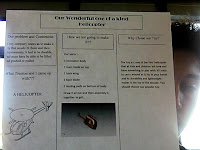1) A brief summary of the challenge so that you introduce an uninformed reader to the nature of the effort. List who your partner is. My partner was Trenton Austin and our challenge in building our helicopter was it had to be durable and must be able to push, pull, lift and had to be hand held. Our objective was to design and model a new toy that was less noisy and smarter
2) Why did you choose the design brief that you chose to work on? We chose to do a helicopter because it seemed like we were the only ones to do a toy and we wanted to try it out and we did pretty good on our helicopter.
3) Share insight on steps 1, 2 and 4 of the 12 step PLTW design process.
Step 1 - Our problem was that a toy company wanted us engineers to build a durable toy that was less noisy and smarter than other toys. We had to make it with 6 different parts and must be able to lift
Step 2 - Trenton and I brainstormed through drawings and talking to each other, we made three sketches of a bike, car, and helicopter and discussed which one would be fun and meet the constraints.
Step 4 - Our criteria was to make a nice toy helicopter for a big time toy company for kids. Our constraints were that it must be durable and had to be able to lift, pull, and push.
Step 12 - We communicated our results through our brochure and talking to the boss (Olson) and showing our final product to companies needed.
4) Post images/scans of your 3 possible solution sketches. Highlight any important features. Sketches should have a scale listed and a description of which perspective is shown. Call out any key features.
Picture #1 - car - has a normal car body with windows and tires
Scale - each grid equals .5 inchs so the car length is 10 in and the width is 4 in wide
Picture #2 - bike - has a simple bike frame with handle bars and two tires
Scale - each grid equals .5 in, so the length is 7.5 in and the height is 5 inch
Picture #3 - our original aircraft - has a normal plane/helicopter body with wings but ended up with blades, has a landing gear.
Scale - each grid equals .25 in, and the length is 9 in and the height is 2.5 in
5) Post an image of your decision matrix and explain results.
Our matrix was a close one between a helicopter and car. The helicopter got 25 points and the car got 23.5 points, but we thought the car would have been a little to easy so we chose the helicopter. A 10 was the best and 1 was the worst
6) Model your solution in Inventor and post appropriate images (alt+PrtScn to take a screen shot of the active window. Use Paint to crop your image).

 7) Images/Scans of your marketing brochure.
7) Images/Scans of your marketing brochure.
2) Why did you choose the design brief that you chose to work on? We chose to do a helicopter because it seemed like we were the only ones to do a toy and we wanted to try it out and we did pretty good on our helicopter.
3) Share insight on steps 1, 2 and 4 of the 12 step PLTW design process.
Step 1 - Our problem was that a toy company wanted us engineers to build a durable toy that was less noisy and smarter than other toys. We had to make it with 6 different parts and must be able to lift
Step 2 - Trenton and I brainstormed through drawings and talking to each other, we made three sketches of a bike, car, and helicopter and discussed which one would be fun and meet the constraints.
Step 4 - Our criteria was to make a nice toy helicopter for a big time toy company for kids. Our constraints were that it must be durable and had to be able to lift, pull, and push.
Step 12 - We communicated our results through our brochure and talking to the boss (Olson) and showing our final product to companies needed.
Picture #1 - car - has a normal car body with windows and tires
Scale - each grid equals .5 inchs so the car length is 10 in and the width is 4 in wide
Picture #2 - bike - has a simple bike frame with handle bars and two tires
Scale - each grid equals .5 in, so the length is 7.5 in and the height is 5 inch
Picture #3 - our original aircraft - has a normal plane/helicopter body with wings but ended up with blades, has a landing gear.
Scale - each grid equals .25 in, and the length is 9 in and the height is 2.5 in
5) Post an image of your decision matrix and explain results.
Our matrix was a close one between a helicopter and car. The helicopter got 25 points and the car got 23.5 points, but we thought the car would have been a little to easy so we chose the helicopter. A 10 was the best and 1 was the worst
6) Model your solution in Inventor and post appropriate images (alt+PrtScn to take a screen shot of the active window. Use Paint to crop your image).

 7) Images/Scans of your marketing brochure.
7) Images/Scans of your marketing brochure. 





No comments:
Post a Comment